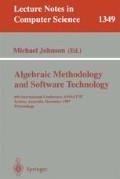Abstract
In the update calculus concurrent processes can perform update actions with side effects, and a scoping operator can be used to control the extent of the update. In this way it incorporates fundamental concepts both from imperative languages or concurrent constraints formalisms, and from functional formalisms such as the λ- and π-calculi. Structurally it is similar to but simpler than the π-calculus; it has only one binding operator and a symmetry between input and output. We define the structured operational semantics and the proper bisimulation equivalence and congruence, and give a complete axiomatization. The π-calculus turns out to be an asymmetric subcalculus.
Work partially supported by ESPRIT BRA project No. 8130: LOMAPS, The Human Capital and Mobility Project EXPRESS, and the working group CONFER-2.
Preview
Unable to display preview. Download preview PDF.
References
H. P. Barendregt. The Lambda Calculus. Its Syntax and Semantics, volume 103 of Studies in Logic and the Foundations of Mathematics. Elsevier, 1984.
R. J. R. Back and R. Kurki-Suonio. Distributed cooperation with action systems. ACM Transactions on Programming Languages and Systems, 10(4):513–554, Oct. 1988.
K. M. Chandy and J. Misra. Parallel Program Design: A Foundation. Addison-Wesley, 1988.
M. Dam. Model checking mobile processes. In E. Best, editor, CONCUR'93: Concurrency Theory, volume 715 of Lecture Notes in Computer Science, pages 22–36. Springer-Verlag, 1993.
Y. Fu. A proof theoretical approach to communication. In P. Degano and R. Gorrieri, editors, ICALP'97: Automata, Languages and Programming, volume 1256 of Lecture Notes in Computer Science, pages 325–335. Springer-Verlag, 1997.
R. Milner. The polyadic π-calculus: a tutorial. Technical Report ECS-LFCS-91-180, Laboratory for Foundations of Computer Science, Department of Computer Science, University of Edinburgh, UK, Oct. 1991.
Z. Manna and A. Pnueli. The Temporal Logic of Reactive and Concurrent Systems. Springer-Verlag, 1991.
R. Milner, J. Parrow and D. Walker. A calculus of mobile processes, Parts I and II. Journal of Information and Computation, 100:1–77, Sept. 1992.
J. Parrow and D. Sangiorgi. Algebraic theories for name-passing calculi. Journal of Information and Computation, 120(2):174–197, 1995.
M. Pistore and D. Sangiorgi. A partition refinement algorithm for the π-calcuius. In R. Alur and T. A. Henzinger, editors, Proceedings of CAV'96, volume 1102 of Lecture Notes in Computer Science. Springer-Verlag, 1996.
J. Parrow and B. Victor. The update calculus (full version). Technical Report DoCS 97/93, Department of Computer Systems, Uppsala University, Sweden, Sept. 1997.
D. Sangiorgi. Expressing Mobility in Process Algebras: First-Order and Higher-Order Paradigms. PhD thesis, Department of Computer Science, University of Edinburgh, UK, 1992.
D. Sangiorgi. On the proof method for bisimulation (extended abstract). In J. Wiederman and P. Hájek, editors, Mathematical Foundations of Computer Science 1995 (MFCS'95), volume 969 of Lecture Notes in Computer Science, pages 479–488. Springer-Verlag, 1995.
D. Sangiorgi. π-calculus, internal mobility and agent-passing calculi. Rapport de Recherche RR-2539, INRIA Sophia-Antipolis, 1995.
D. Sangiorgi. A theory of bisimulation for the π-calculus. Acta Informatica, 33:69–97, 1996.
G. Smolka. A foundation for higher-order concurrent constraint programming. In J.-P. Jouannaud, editor, Proc. 1st International Conference on Constraints in Computational Logics, volume 845 of Lecture Notes in Computer Science, pages 50–72. Springer-Verlag, Sept. 1994.
B. Victor and F. Moller. The Mobility Workbench — a tool for the π-calculus. In D. Dill, editor, CAV'94: Computer Aided Verification, volume 818 of Lecture Notes in Computer Science, pages 428–440. Springer-Verlag, 1994.
B. Victor and J. Parrow. Constraints as processes. In U. Montanari and V. Sassone, editors, CONCUR'96: Concurrency Theory, volume 1119 of Lecture Notes in Computer Science, pages 389–405. Springer-Verlag, 1996.
Author information
Authors and Affiliations
Editor information
Rights and permissions
Copyright information
© 1997 Springer-Verlag Berlin Heidelberg
About this paper
Cite this paper
Parrow, J., Victor, B. (1997). The update calculus. In: Johnson, M. (eds) Algebraic Methodology and Software Technology. AMAST 1997. Lecture Notes in Computer Science, vol 1349. Springer, Berlin, Heidelberg. https://doi.org/10.1007/BFb0000486
Download citation
DOI: https://doi.org/10.1007/BFb0000486
Published:
Publisher Name: Springer, Berlin, Heidelberg
Print ISBN: 978-3-540-63888-9
Online ISBN: 978-3-540-69661-2
eBook Packages: Springer Book Archive

